by Lisa Cooke | Aug 1, 2019 | 01 What's New, Research Stories |
Lessons in life often translate to lessons in genealogy. Here’s an example of how digging deeper can have you singing a happier research tune.
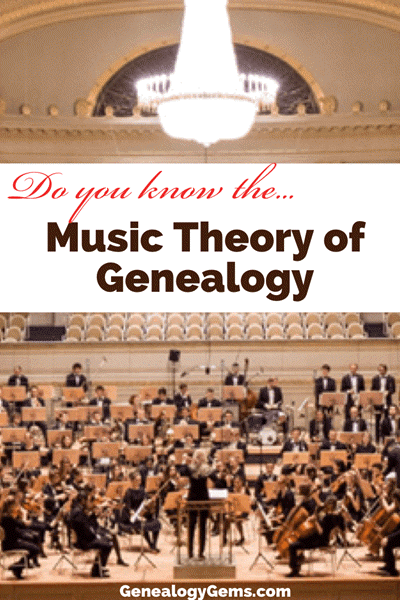
The Music of My Childhood
When I was a kid I had a million interests (and I still do.)
I loved art of all kinds – painting, drawing, and paper mache. I enjoyed baking and particularly candy-making. I had a teal blue easy bake oven I used constantly, and a cotton candy making machine that spun sugar into treats – Yum!
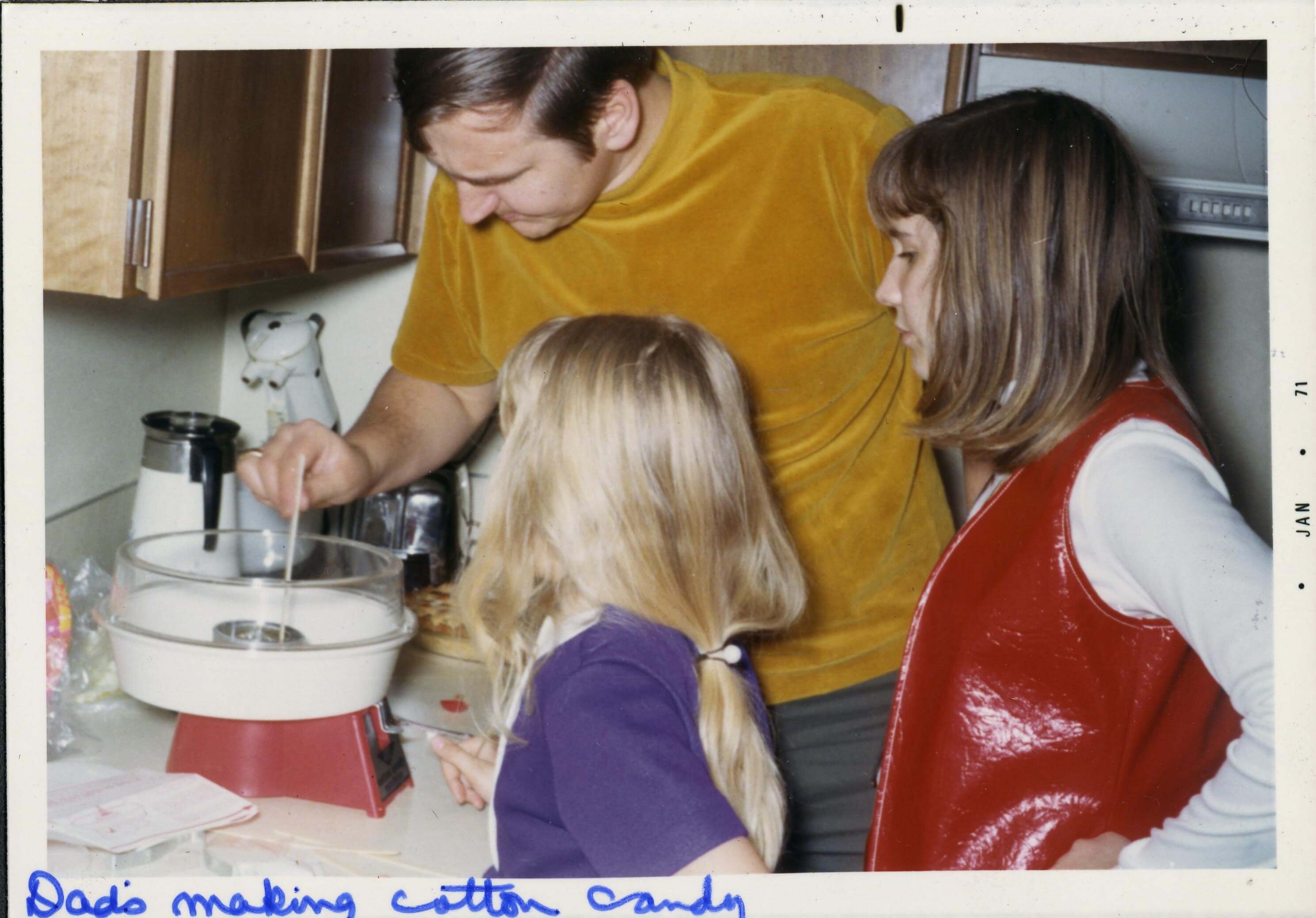
Making cotton candy with my Dad, Christmas 1970.
At the age of eight I learned to water-ski. It came surprisingly easy, so much so that my Dad got me a pair of short trick skis on which I learned to do a full 360 degree turn.
And like most kids I took piano lessons starting in the first grade. My mom bought an old upright piano for $75, and painted it bright red (you can see where I got my artistic flair from!)
My first piano teacher was a lovely lady who happened to be a paraplegic. This meant that she sat across the room from me and the piano and never actually touched the piano. I learned a love of music from her for which I’ll always be grateful. She was a patient teacher with her rambunctious student. But years later after we moved and I started up with a new piano teacher, I discovered I was clueless about fingering which was why many songs seemed unreasonably difficult to me.
It’s eye-opening to realize you didn’t know what you didn’t know.
Something else that slowed me down was not really learning music theory. Oh I had learned the basics, and became a laser-focused sight-reader of music. But my while my second teacher taught me scales, I don’t recall her ever saying why we were doing them. Needless to say, I didn’t practice them because I didn’t know why we were bothering with these notes that weren’t songs. Therefore, I never learned them or their significance to music.
One of my all time favorite songs was and still is One Less Bell to Answer by the Fifth Dimension. I first heard it on the TV series It Takes a Thief starring Robert Wagner which ran from 1968 to 1970. The song was featured in the third season episode called Sing a Song of Murder.
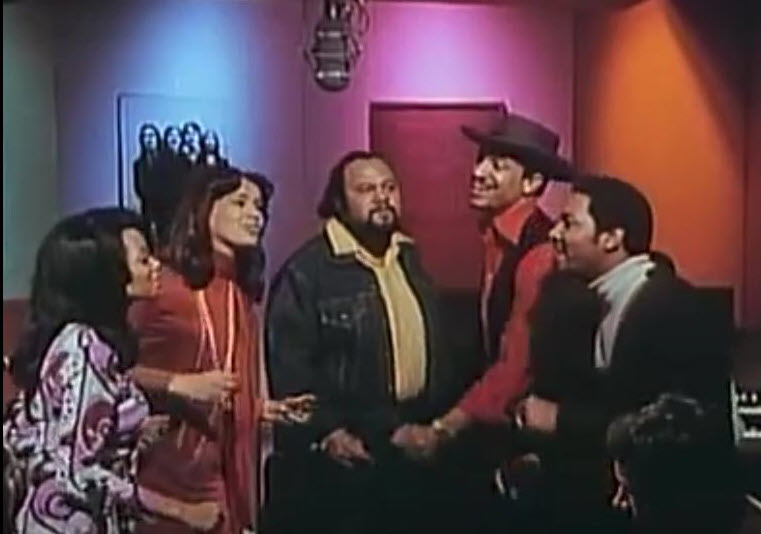
5th Dimension on Sing a Song of Murder
The 5th Dimension were the guest stars that week, and Marilyn McCoo sang that torch song like no one else could. I drove my mom crazy as I belted it out from the top of my lungs and begged her for 5th Dimension albums for my birthday. I still have my original 5th Dimension Live double album and the 5th Dimension Greatest Hits on Earth, both of which feature the song.
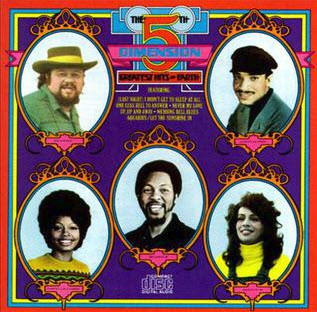
Harder than the Average Song
The other day I was falling down a rabbit hole on Instagram where I saw that Marilyn McCoo and her husband Bill David, Jr. had started an Instagram account (you can follow them here). I started following them, enjoying reading about how they are celebrating their 50th anniversary this year, and seeing old TV clips and new video of their performances.
I got to thinking about that To Catch a Thief episode and soon the rabbit hole led me to YouTube where I watched it. From there I found a tunnel to MusicNotes.com where I bought the sheet music for One Less Bell to Answer.
I sat down, excited to play it, and was stopped in my tracks. This Burt Bacharach and Hal David classic was as hard to play as any of Liszt’s classics!
Although I have continued to play piano all these years, I slogged and fumbled and scratched my way through to the end. My weakness in fingering skills and music theory was painfully apparent. I decided there and then that I wanted this one badly enough that I was willing to go back to the basics, learn what I didn’t know about music, and practice daily.
And so I found myself a good video series on music theory basics. I’ve been devoting a half an hour each day to learning the Circle of Fifths, scales and chords. I also put my husband through listening to me do another half an hour a day of practice, with an emphasis on One Less Bell to Answer. My husband says I’m getting better, though I’m still frustrated that it’s not yet quite where I want it to be.
Along the way though, something really interesting has happened.
I have noticed something wonderful after each painful, slow study and practice session. When I go back to my regular music (my sheet music stack includes the likes of Supertramp, Fleetwood Mac, Bach, Beethoven, Billy Joel, one of my favorite composers, Mr. Rogers), that music is much easier, and I’m much better at playing it! In fact, it’s more of a joy to play than ever, and I usually end up playing another hour in the evening, giving up time previously wasted on television.
So what does this have to do with family history and genealogy? Well…
Mastering the Music of the Genealogical Brick Wall
One Less Bell to Answer was not only my favorite song, but one of the toughest to master. So let me ask you, what’s your toughest genealogy case right now?
We all have a brick wall or two that has plagued us. I get emails every day from listeners of the Genealogy Gems Podcast outlining the family history challenge that has them stumped. Sometimes I think their hope is that I might have a genealogical silver bullet, or that I might be aware of some low-hanging genealogical fruit that they’ve over looked. I always encourage listeners to write in because many times there is a quick source or strategy that I can offer that they just may have missed. Or I can refer them to one of our articles, videos or podcast episodes that can provide a more in-depth answer. There’s always value in sharing with others the research challenges we face, and soliciting ideas and input.
However, in many cases, the answer is not so simple. Many of the cases described go well beyond a quick search at one of the Genealogy Giants websites. (You can learn more about them here.) These are cases that don’t have an easy answer. There isn’t one source just waiting to be found.
Sing a Song of Genealogy
Genealogical brick wall cases are much like the most glorious torch songs. They will require more education, steady relentless work, and a willingness to end each research session (like a piano practice session) unsatisfied with the current results. But when we stay focused and persist, we can remain optimistic that the end result will be worth it.
This answer to tough genealogical questions isn’t a popular one. That’s due in part to the increased tech tools and vast online databases (which are all fantastic boons for the genealogist by the way), that appear to offer instant gratification. This auto-generated “genealogy” can actually dilute our research edge when we really need it. We can be lulled into believing there should always be a quick fix. We find ourselves not as willing to stop, create a research plan, set up a tracking spreadsheet, and execute a plan to find the answer.
Many a family tree (particularly online) is filled with errors created by an unwillingness to take the time to dig deep. For example, are we really sure we have the right ancestor when there are several men by that name in that county at that time? Did we really prove it?
Genealogy Research Plans
Is creating and using a genealogy research plan new to you? That’s not usual.
These days, many people first come to climbing their family tree through a genealogy app. Several of the popular genealogy apps allow you to instantly start adding what you know already about your family to your family tree on the app. Then the app starts serving up record hints and matches – genealogical records it thinks may match the people you have added. It may also connect you to other users who share branches of your family tree.
While there’s a bit of instant gratification in all this, it doesn’t help us see the bigger picture, or develop our skills as a researcher. In a sense, we are following the app’s research plan (and I use that term very loosely here), rather than developing and conducting our own research plan.
When we finally take up the baton, and start leading our own research, we will gain more satisfaction and end up singing the right song.
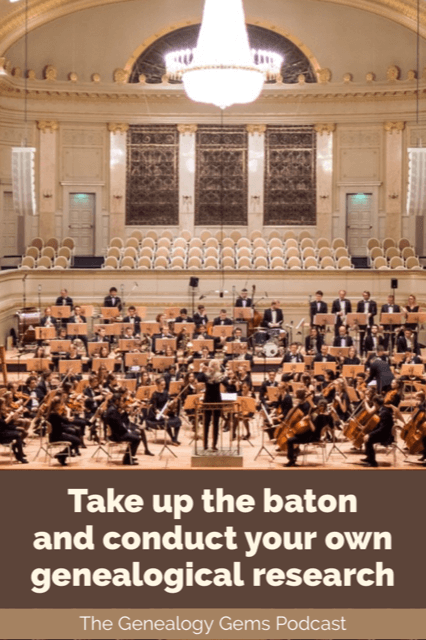
To learn more about genealogy research plans, read my article Which Way Do I Go Now? Organize a Genealogy Research Plan. Genealogy Gems Premium members can watch the Premium video Using Evernote to Create a Research Plan here. (Membership and log in required.)
Finding Genealogical Answers
If you’re facing an imposing genealogical brick wall, why not set aside all your other searches, and just work on this one? Slog along, fight your way through it! Do it for an hour every day. If your knowledge is lacking, go find the answers. Get up to speed on the areas you don’t know enough about.
It helps to accept that this genealogical answer that you seek, like a really wonderful song, is going to require more learning and practice than the average answer. But when it’s done, you’ll have the satisfaction of having conquered a really tough one, and the confidence that you got it right.
I can promise you this. When you take the time to craft and work a real and true genealogical research plan, you’ll be pleasantly surprised that when you go back to your other research, you will find it easier, and more enjoyable.
And yes, I’m still working on mastering my favorite song. Follow me on instagram and when I have it mastered, I’ll play it for you.
Please use the social buttons at the top of this post to share it with your genealogy friend.
by Lisa Cooke | Mar 11, 2017 | 01 What's New, RootsMagic |
A GEDCOM file is a universal type of file that genealogists use to move data from one genealogy software program to another. Using these helpful tips below, you can open genealogy files your family members send to you, or share your data with others.
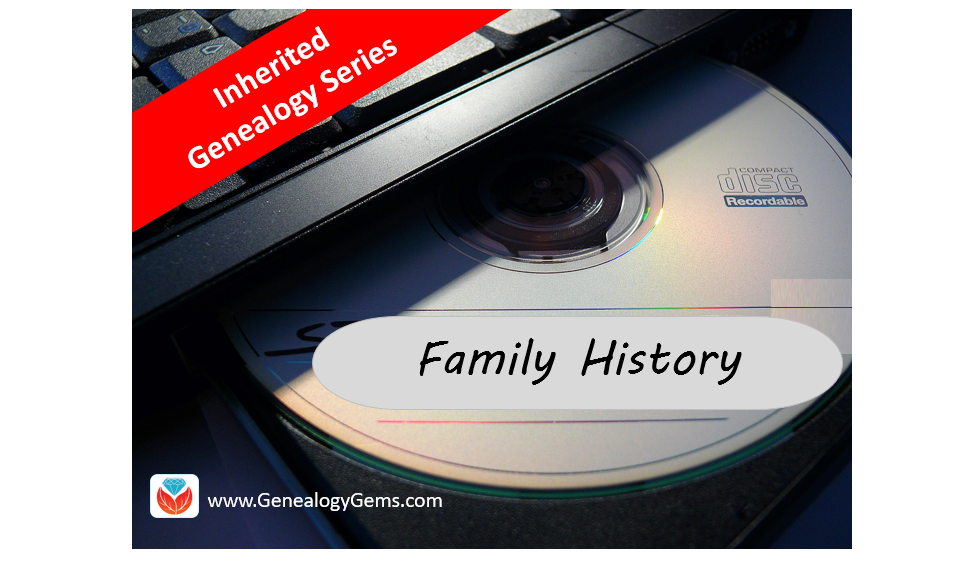
When and Why You Would Need to Open a GEDCOM File
A Genealogy Gems reader recently wrote:
I recently signed up for [the Genealogy Gems] newsletter. I received a CD from a relative with family history information that was set up through Family Tree Maker. I am currently not subscribed to any of the genealogy sites. My question is, how can I retrieve this information [from the CD.] Can you help?
The answer to the question is: Use another program to open the GEDCOM file from the CD. Let me show you how easy it is to open and create GEDCOM files.
GEDCOM Basics
GEDCOM is an acronym standing for Genealogical Data Communication. It is a universal genealogy file that allows you to exchange genealogical data between different genealogy software programs.
Because it is “universal” in nature, a GEDCOM file can be read by many different types of genealogy software. That means, if you are using RootsMagic, you can still share all the data you have collected with your cousin who uses Family Tree Maker, and she will not have to type in all the names, dates, and places manually.
Occasionally, not all the information included in a GEDCOM file will transfer perfectly. There are differences in how that information is interpreted and some things, like notes and sources, may be affected. However, for the most part, much of it will transfer correctly.
How to Open a GEDCOM File
Our reader needs to open a GEDCOM file contained on the CD he was sent. To do this, he must have a program on his computer that will read a GEDCOM file. There is an option I would like to share with you.
RootsMagic is a downloadable software for both Mac and PC users. (And, it is the one we here at The Genealogy Gems Podcast use! That’s why we accepted them as a sponsor of the podcast.)
Once you have downloaded RootsMagic to your computer, open it. At the top left corner, click on File and from the pull-down menu, choose Import.
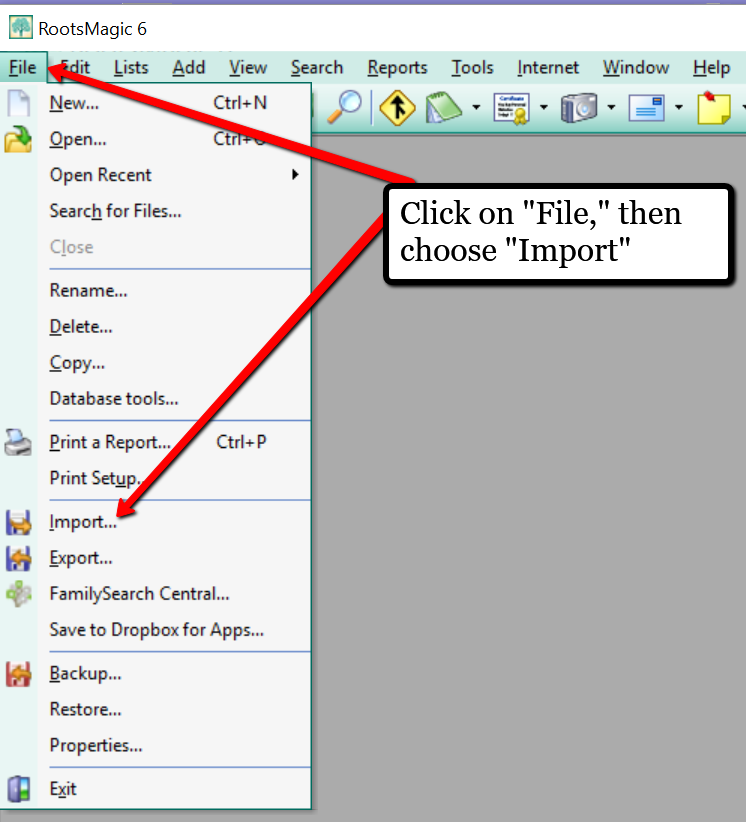
Now, a new pop-up window will open and ask from what source you would like to import from. You will notice several options, but for our reader’s question, he will choose the GEDCOM option.
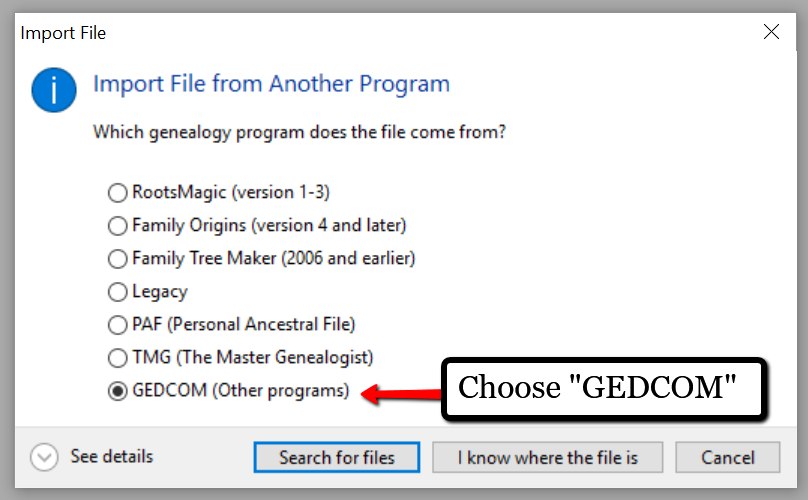
Then, choose I know where the file is, and the file explorer window will appear. In this case, our reader would click on the CD that he has loaded into his computer’s disk drive, and follow the prompts to open the GEDCOM file. All that information his relative sent him will be slurped into RootsMagic and he can easily look through the pedigree of his family.
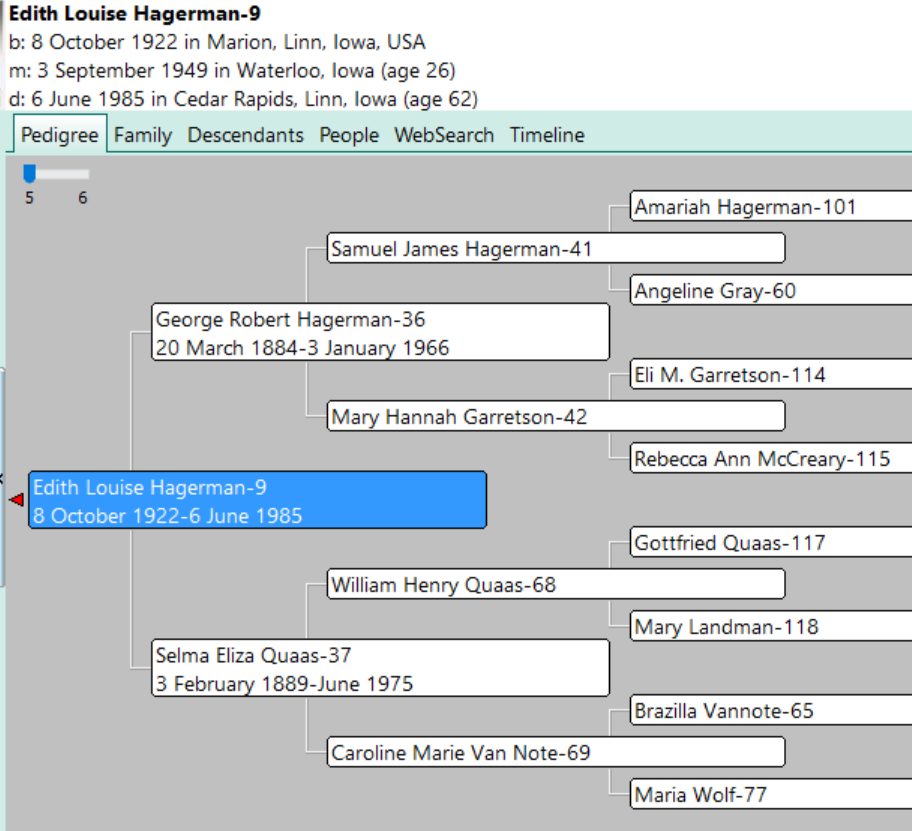
Creating a GEDCOM to Share with Others
RootsMagic also allows you to create a GEDCOM file. This is what you would send to your relatives when they would like to have a copy of the family tree.
To do this, open RootsMagic. Click on File, as we did before, and this time choose Export from the pull-down options.
The export box will pop-up. You can choose what you wish to have included in this export. I typically choose Everyone, but you can do yours by family names by clicking on the down arrow next to Everyone and choosing Select from list.

Once you have clicked OK, the GEDCOM file is ready to be saved to your computer. Save the file on your desktop or somewhere you will be able to locate it again. Remember to name the file and pay attention to where you are saving it!
Creating a GEDCOM from Ancestry.com
If you have stored your genealogy data at Ancestry.com, you may be interested to know that you can create a GEDCOM file for your family tree there as well. It’s just a matter of signing into your Ancestry account, locating the Tree Settings, and then clicking Export. I found a nice article outlining the steps on how to do that here.
Protecting Your GEDCOM Files
Creating a GEDCOM is also a great way to save or backup your hours and hours of family history research. One of the saddest tales of genealogists everywhere is losing their computer or printed family files with all that work!
GEDCOM files can be saved to a hard drive, saved to an external unit, emailed, put on a thumb drive, or uploaded to the Cloud. You can also invest in a company like Backblaze, the official backup of The Genealogy Gems Podcast, that will automatically backup all your files. (Read more about Backblaze, here.) All of these methods protect you and your genealogy.
More on Protecting Your Genealogical Data
Learn more about Backblaze, The Genealogy Gems Podcast’s first choice when it comes to backing up precious genealogy research and personal files. Read the article’s below and determine if Backblaze is the answer you’ve been looking for.
How to Download Backblaze in 4 Easy Steps
Backing Up Your Genealogy with Backblaze – Q & A
by Lisa Cooke | Sep 28, 2013 | 01 What's New, Book Club, Inspiration, Research Skills
The Library of Congress has a new quick video tutorial to help us find things in their enormous collections, both offline and online.
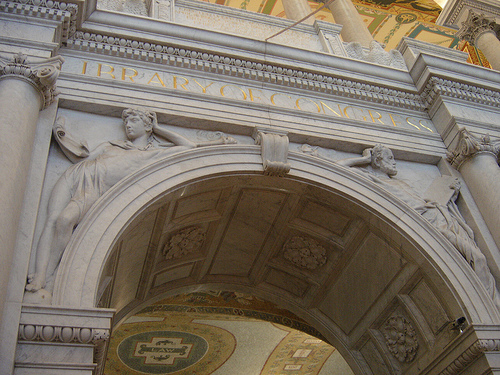
Flickr Creative Commons image by Paull Young.
“How to Find Stuff at the Largest Library in the World” is a 5-minute introductory video. It shows how to use subject headings, research databases and other helpful tools to find books, photos, sheet music, manuscripts and more at the Library of Congress or other locations.
This video makes the Library of Congress seem much less intimidating. And we get some tempting glimpses of the inside of the Library. The tips they mention are helpful for navigating any research library though, so check it out!
by Lisa Cooke | Mar 29, 2017 | 01 What's New |
Alaska genealogy researchers celebrate an important milestone. It’s the 150th anniversary of the Alaska Purchase. This special commemoration includes a photography exhibit, musical program, and much more. Keep reading to learn more about resources for Alaska genealogy.
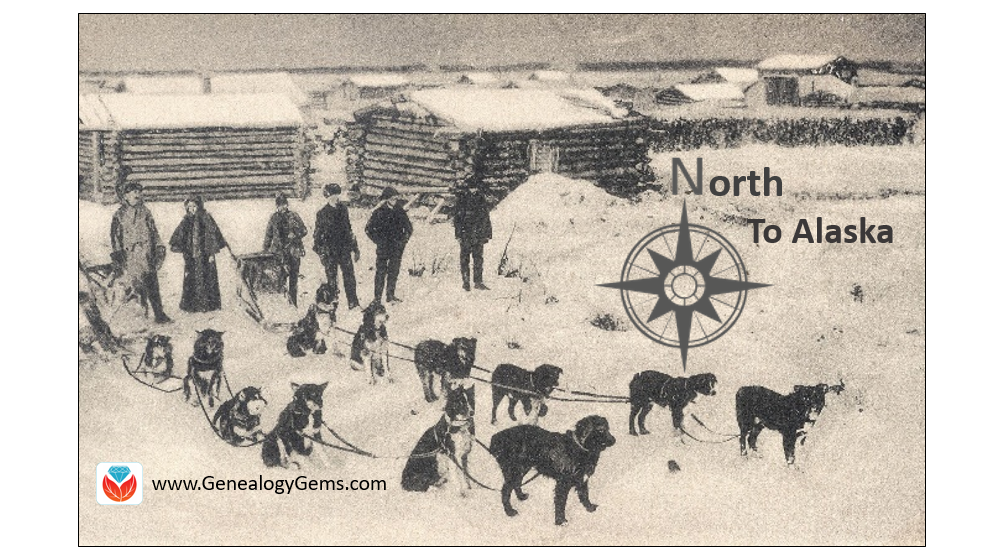
The National Archives is celebrating the sesquicentennial (150 years) of the Alaska Purchase with a special Hidden Treasure Alaska panoramic photography exhibit at the National Archives at College Park. It will also include a presentation by the exhibit curator, a musical program at the National Archives Museum in Washington, DC, and a loan to Polar Bear Garden exhibit at the Anchorage Museum. The National Archives programs and exhibit are free and open to the public.
The Musical Program
The musical program will be held on Thursday, March 30, at 7:30 p.m. at William G. McGowan Theater, Washington, DC. On March 30, 1867, U.S. Secretary of State, William Henry Seward, signed the Alaska Treaty of Cession that purchased Russian America. To commemorate the life and contributions of Seward, the State of Alaska is sponsoring a performance of the Alaska chamber group, Wild Shore New Music. Wild Shore will perform the work of living composers who have found inspiration through their experiences with the natural beauty and indigenous cultures of Alaska. Reservations are recommended and can be made online.
The Exhibit
The Hidden Treasure exhibit will be at the National Archives at College Park, MD, on the lower level. Hidden Treasure dramatically captures the beauty of Alaska, as captured on film by U. S. Geological Survey (USGS) topographers from 1910-1932. These extraordinary images of more than 6,000 panoramic photographs from the collection were used, but then stored and remained unseen for decades. Thanks to the research, work, and photographic skill of National Archives expert Richard Schneider, these images can now be seen by the public in their original panoramic format for the first time. These images capture work-life in the Alaskan wilderness, surveying techniques, towns, and geological formations, such as the Columbia Glacier. See Richard Schneider’s related Prologue Magazine story: The Alaskan Frontier in Panorama – How the National Archives Preserved Early 20th-Century Photographs.
Schneider will discuss these historic panoramic photographs of the Alaska Territory in his presentation on Wednesday, April 12th at 2 p.m. EST. You may see it live streamed at the William G. McGowan Theater & YouTube.
Polar Bear Garden
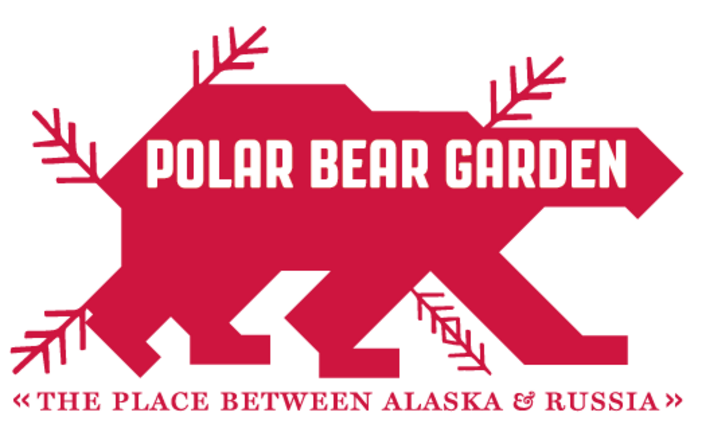 Beginning March 3rd through September 17, 2017, The Polar Bear Garden exhibit will be on display at the Anchorage Museum in Anchorage, Alaska.
Beginning March 3rd through September 17, 2017, The Polar Bear Garden exhibit will be on display at the Anchorage Museum in Anchorage, Alaska.
Archival and contemporary photographs combined with nesting dolls, cartoons, feature-length films, and Cold War propaganda will take viewers on a journey between Alaska and Russia since the purchase. It will further explore stereotypes, language, storytelling, boundaries, and crossings. The exhibit highlights are on rare loan from the National Archives and include the original cancelled check and President Andrew Johnson’s Ratification of the Treaty. More information about the Polar Bear Garden can be found online.
Alaska Genealogy
Your Alaskan heritage will likely include stories of great strength and perseverance. To begin your Alaska genealogy research, you may wish to review the FamilySearch Wiki article titled Alaska, United States Genealogy. In it, you will learn important tips like the fact that Alaska is not divided into counties, as nearly all the other states are. Instead, Alaska is divided into boroughs.
There is also a free guide on the wiki titled Step-by-Step Alaska Research, 1880-Present that you may particularly helpful. Among other things, it will help you located birth, marriage, and death records; wills and probates; and naturalization and immigration records.
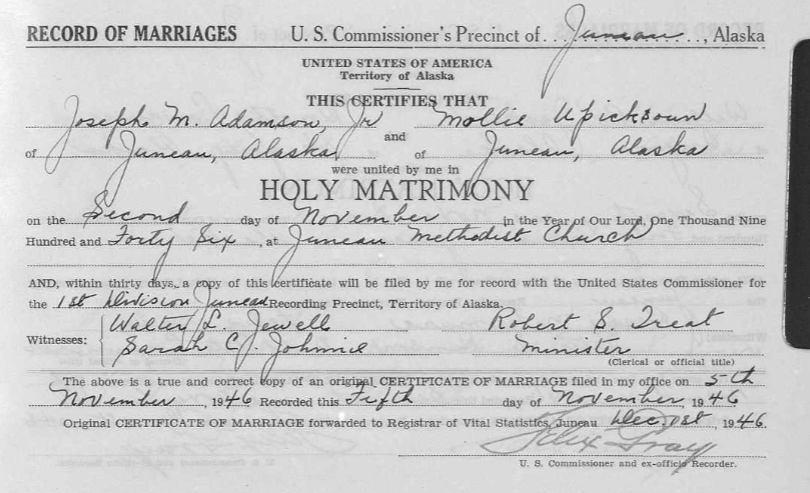
Marriage record found online at FamilySearch.org in collection titled “Alaska, Vital Records, 1816-1959”
Additionally, the Alaska State Archives have resources available. They hold many records that contain information on individuals such as:
Lastly, check out the Alaska Genealogy online guide provided by the Alaska State Library. This basic guide of Alaska related genealogy resources is not intended to be comprehensive, but it is certainly a step in the right direction. Sources for several of the boroughs may be available in other Alaska libraries or through interlibrary loan at your local library. They include:
More Resources for Alaska Genealogy Research
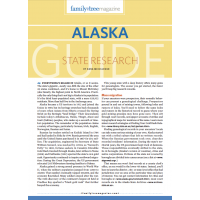 The Alaska State Research Guide Digital Download by Family Tree Magazine is a digital download you will want to have for your genealogy library. Trace your Alaska ancestors with the advice and resources in this four-page download. It includes:
The Alaska State Research Guide Digital Download by Family Tree Magazine is a digital download you will want to have for your genealogy library. Trace your Alaska ancestors with the advice and resources in this four-page download. It includes:
- a how-to article detailing Alaska history and records, with helpful advice on tracking your family there
- the best websites, books and other resources for Alaska research, handpicked by our editors and experts
- listings of key libraries, archives and organizations that hold the records you need
- descriptions of the top historic sites for learning about your ancestors’ lives and times, including visitor information
- timeline of key events in the state’s history
- full-color map to put your research in geographical context
Happy hunting…or should I say mushing!
by Lisa Cooke | May 28, 2015 | Beginner, Digital Archives, Libraries, Listeners & Readers, Research Skills, Travel, United States
 Recently we heard from Jennifer, who wondered what kinds of genealogy resources she might discover in a state capital.
Recently we heard from Jennifer, who wondered what kinds of genealogy resources she might discover in a state capital.
“I’m tagging along on my husband’s thesis research trip to Columbus, Ohio. I have some ancestors from other parts of Ohio. I was wondering what exactly I could look for in a state’s capital collections/archives that could save me a trip to the city or county? I was thinking that the state capital may have a “gem” that I couldn’t find elsewhere, or even duplicated information [from local repositories]. Do you know?”
Yes, Jennifer is definitely thinking along the right lines! Here’s our advice:
At the state level there are often two key resources: the state library and the state archives. These might be combined. One might be called the state historical society. You just have to look for each state. In Ohio, the Ohio History Connection serves as the state historical society and official state archives. But there is also a state library that serves as a repository for government documents and a resource for other libraries. Each has resources for genealogists, online and in-house. (Click here for digital genealogy content at the state library and here for resources at the Archives/Library of the Ohio History Connection).
In addition, public libraries of major cities often have excellent local history and genealogy collections. This is definitely true of the Columbus Metropolitan Library in Ohio’s state capital!
We suggest you contact librarians before you go and ask what they have that can’t be found anywhere else, both on a state level and for locales you are researching. Often times that will include photograph collections, company (business) collections, and my favorite newspapers on microfilm. If you can formulate specific genealogical questions that you want to try and answer and share those ahead of time with the librarian that will help her guide you toward the unique gems. Every state library and archive is unique, so consulting by phone with the reference librarian is the best way to go.
 Here are a few articles on my website that can help you prepare to find genealogy records in a state capital repository or in any major library:
Here are a few articles on my website that can help you prepare to find genealogy records in a state capital repository or in any major library:















 The Alaska State Research Guide Digital Download by Family Tree Magazine is a digital download you will want to have for your genealogy library. Trace your Alaska ancestors with the advice and resources in this four-page download. It includes:
The Alaska State Research Guide Digital Download by Family Tree Magazine is a digital download you will want to have for your genealogy library. Trace your Alaska ancestors with the advice and resources in this four-page download. It includes:
